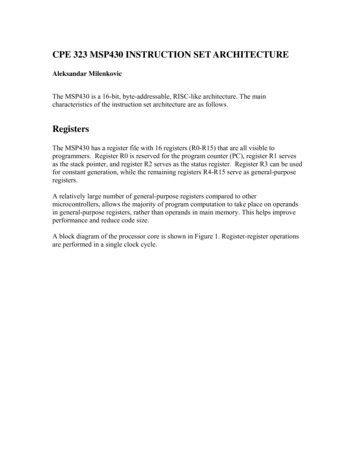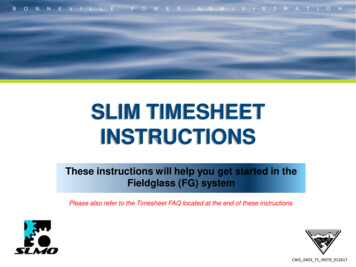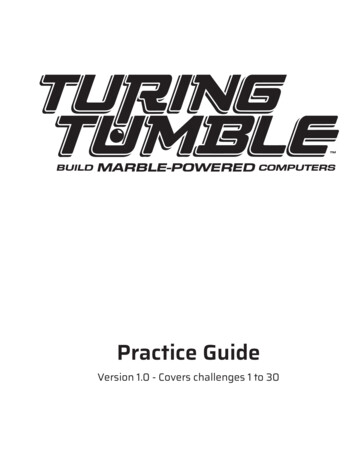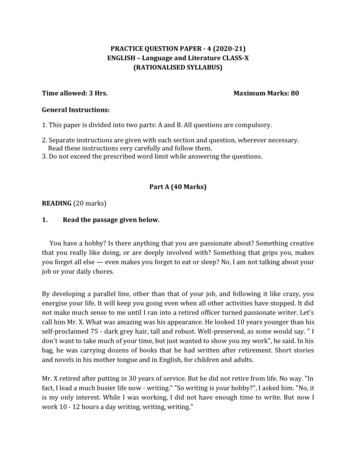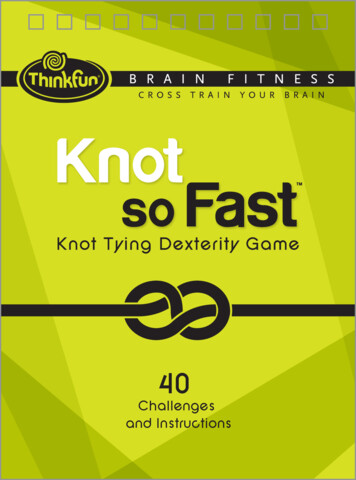
Transcription
40Challengesand Instructions
ThinkFun’s Brain Fitness games are designed as a fun way to help youexercise your brain. The 40 challenges will stretch your mental muscles,strengthening speed, focus, and memory. We recommend that you startwith the beginner level and work your way through the challengesprogressively. Just 15 minutes of play a day will reduce stress and provide agood brain workout. You’re on your way to a healthier brain!Includes: 40 Challenges with Instructions & Fun Facts,Rope, and Metal Tying Ring.It’s a shame that knot tying is somewhat of a forgotten art. Not only is itan impressive skill that could save you from some pretty sticky situations,but it’s a really great brain exercise too! Have you ever watched a childlearn to tie shoelaces? This seemingly simple task can be a mental workoutrequiring fine motor skills and manual dexterity. But, with some practice,it’s pretty easy to master.Knot tying will put your dexterity, critical thinking, and visual perceptionskills to the test. And, once you’ve mastered a knot, you can use memoryto try recreating it as quickly as possible.So, now that your brain’s in good shape, stop playing, and go dosomething useful with your new skill!
The Object: Choose a challenge and recreate the pictured knot.To Play: Start Tying! You may find it helpful to begin by identifying one endof the rope as your starting point and following it through the knot to theother end. Once you’ve mastered a knot, use a timer and challengeyourself to tie it in 30 seconds or less!If You’re Stuck: Start at one end of the rope and pay careful attention tohow it weaves over and under itself and the ring. By following the ropeclosely (and even tracing it with a finger), you’ll find it easier to see howthe knot was created.About the Inventor:Dugald Keith, born in Melbourne, Australia, majored in physics andworked in high technology before becoming a full-time board game andpuzzle inventor. His inventions have won numerous awards.Knot Consultant, Des Pawson, MBE:A professional ropeworker for more than 35 years, Des Pawson is theauthor of a number of books on knots and ropework. He is co-founder andpast president of the International Guild of Knot Tyers. In 2007, he wasawarded the MBE (Member of the British Empire) by Queen Elizabeth IIfor his contribution to the world of knots and rope.
Notes about Knots:Knots may be the earliest tools invented by humans–virtually all knotswere invented using reasoning and craftsmanship to create new tools.They were used to help make clothes and to hunt using spears and arrows;early sailors had to be masters at knot tying in order to survive. The KnotSo Fast challenges fall into five major categories. Read about eachcategory to get ideas on how you can use your knots.Knots Categorized by Function:We have chosen the Knot So Fast challenges from six major categories.To identify which category a knot belongs to, look on the challenge pagefor the icon.STOPPER KNOTSStopper knots are usually used to stop a rope from slipping through ahole. They are also used to prevent the strands at the end of a rope fromfraying, to weight a rope or to provide a handhold. They are usually tiedat the end of a rope, although some can be tied in the middle.BINDINGSBinding knots are used to keep a rope from slipping or releasing its holdtoo easily, such as when tying up parcels. Avoid using a binding knot tojoin two lengths of rope or to tie a rope to an object, since the knot is likelyto come undone under strain.
BENDSA bend is used to join two lengths of rope together, lengthening theprincipal rope. For most bends, the ropes need to be of equal thicknessto tie a secure knot. A few bends are suitable for joining ropes of twodifferent thicknesses. A good bend can be easily untied, even after beingput under considerable strain.HITCHESA hitch is used to tie a rope to an object, often a pole or a ring. Somehitches are designed to be tied quickly and hold tight, particularly thoseused by sailors, while others can be untied with a brief tug on one end.LOOPSLooped knots create a loop that may be tied to another object or line.A loop may be dropped loosely over an object to fix a rope in place, tiedaround a person’s waist or wrist, or threaded through a ring or an eye ofa hook. Loops can also be linked together to join two ropes that aresubstantially different in thickness. Some loops are fixed in place, whileothers are designed to slip and change size.DECORATIVE KNOTSKnots can be attractive and decorative in addition to being useful.Decorative knots often exhibit symmetric patterns which make themvisually appealing.
BEGINNER1FUN FACT: The Overhand is the most basic ofknots. It can be used to tie a string around yourfinger to remind you of something important.
BEGINNER2FUN FACT: When tied properly, the Slip Knotcomes undone with just a tug on the rope'sfree end.
BEGINNER3FUN FACT: The Figure Eight Knot is used onsailboats to prevent a rope from slippingthrough a pulley.
BEGINNER4FUN FACT: Sometimes called a Cow Hitch or aLarks Head, the Ring Hitch is used to fasten arope to a ring.
BEGINNER5FUN FACT: In a pinch, the Clove Hitch can beused to bind together loose objects, like a pileof sticks, for easy carrying.
BEGINNER6FUN FACT: The Overhand Loop is one of thesimplest and quickest knots to tie, which couldmake it handy in an emergency.
BEGINNER7FUN FACT: The Figure Eight Loop is a climber’sbest friend, because it is so strong but also easyto tie and easy to undo.
BEGINNER8FUN FACT: When worked tight, the DoubleOverhand makes a perfect knot to put betweenmacrame beads.
BEGINNER9FUN FACT: The Reef Knot has been used forhundreds of years to tie down sails on ships instrong winds.
BEGINNER10FUN FACT: The Stevedore Knot can be tied asa stopper at the end of a rope when the FigureEight isn't big enough to keep it from pullingthrough a hole.
INTERMEDIATE11FUN FACT: Tie a Harness Loop in the middle ofyour climbing rope to use it for hauling suppliesup the mountain with you.
INTERMEDIATE12FUN FACT: If you need to tie your horse to afence post, Two Half Hitches might be the knotfor you!
INTERMEDIATE13FUN FACT: The Round Turn & Two Half Hitchesis best used to tie a rope around an object like adock piling.
INTERMEDIATE14FUN FACT: Use a Carrick Bend when tying aparticularly heavy rope or cable that does notform easily into other knots.
INTERMEDIATE15FUN FACT: Originally called the Bow Line Knot,and used to attach a rope to the sail, it is still oneof the best knots for this job.
INTERMEDIATE16FUN FACT: When sailors need to retrieve anythingfloating overboard, they use a Running Bowline.
INTERMEDIATE17FUN FACT: The Lariat Loop is what sits at the endof a cowpoke's lasso. Great for roping steer!
INTERMEDIATE18FUN FACT: Forming a rope seat with Bowline ona Bight is easy. It's hoisting a sailor aloft to cleanthe rigging that takes skill!
INTERMEDIATE19FUN FACT: To lift an injured friend, tie aPortuguese Bowline, with one adjustable loop asa seat and the other around their chest.
INTERMEDIATE20FUN FACT: As its name suggests, theFisherman’s Knot has long been used to joinfishing lines, but it can slip on modernnylon lines.
ADVANCED21FUN FACT: On large sailing ships, buntline ropeslift the middle portion of each sail. The BuntlineHitch is designed to resist the flapping of the sail.
ADVANCED22FUN FACT: The Surgeon's Knot is most often usedby medical personnel to tie off fresh sutures.
ADVANCED23FUN FACT: The Tom Fool Knot, quickly tied anduntied, can make for a fun trick. Now you see it,now you don't.
ADVANCED24FUN FACT: The Handcuff was used out West toprevent horses and grazing animals from wanderingaway and getting lost during the night.
ADVANCED25FUN FACT: Invented around 1910, the AshleyStopper Knot is the largest of the stoppers youmust master to win this game.
ADVANCED26FUN FACT: The Alpine Butterfly Bend is a knotthat works well for joining two ropes together.
ADVANCED27FUN FACT: If you are fishing with a lure insteadof a worm, use an Improved Clinch Knot tosecure the lure on your line.
ADVANCED28FUN FACT: Believe it or not, an Angler's Loop isone of the few knots that can actually be tiedsecurely in a bungee cord.
ADVANCED29the Anchor Bend, makes a strong knot that hastraditionally been used to secure a ship's anchor.FUN FACT: The Fisherman's Bend, also known as
ADVANCED30FUN FACT: The Double Sheet Bend is mosthelpful when used to connect a thin rope (lightorange side in illustration) with a thicker one (darkorange side).
EXPERT31FUN FACT: The Sheepshank is used to shortena rope that’s too long by taking up the slackwithout getting tangled.
EXPERT32FUN FACT: With its extra tucks, the Cat’s Paw iseven more secure than the Ring Hitch and workswell on a cargo hook.
EXPERT33FUN FACT: If your rope is too short, you can use aHunter's Bend to join it with another one.
EXPERT34FUN FACT: Ken Tarbuck invented the TarbuckLoop for climbing with the new nylon ropes thatcame into use after World War II.
EXPERT35FUN FACT: The Half Windsor Knot was namedafter King Edward VIII, later The Duke of Windsor,who was said to prefer wide knots in his neckties.
EXPERT36FUN FACT: Sometimes confused with the ReefKnot (also called the Square Knot), this is fordecoration and can be tied nicely in a long,thin scarf.
EXPERT37FUN FACT: The Water Bowline is the knot to usewhen your rope will have to hold under very wet orslippery conditions.
EXPERT38FUN FACT: The Single Strand Plait looks a lot likea hair braid and makes a nice fancy end to a rope.
EXPERT39FUN FACT: The Blood Knot is commonly used bymany types of fishermen, but it's especially lovedby those who prefer fly fishing.
EXPERT40is a decorative knot frequently used in traditionalChinese clothing.FUN FACT: True to its name, the Chinese Button
ThinkFun's Mission is toIgnite Your Mind! ThinkFun is the world’s leader in addictively fun gamesthat stretch and sharpen your mind. From lightingup young minds to creating fun for the whole family,ThinkFun’s innovative games make you thinkwhile they make you smile.www.ThinkFun.com 2014, 2018 ThinkFun Inc. All Rights Reserved.MADE IN CHINA, 106. #87092. CH01.
at the end of a rope, although some can be tied in the middle. BINDINGS Binding knots are used to keep a rope from slipping or releasing its hold too easily, such as when tying up parcels. Avoid using a binding knot to join two lengths of rope or to tie a rope to an object, si
